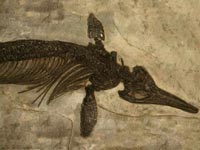Introduction to the TetrapodaThe Four-Legged Vertebrates | ||||
| ||||
|
The word "Tetrapoda" means "four legs" in Greek. Amphibians, reptiles (including dinosaurs and birds) and mammals are the major groups of the Tetrapoda.
| ||||
| ||||
|
Tetrapods are part of a larger groups called Sarcopterygii, which also includes several groups of lobe-finned fish, such as lungfish and the coelacanth. The Sarcopterygii are just one group of vertebrates, or animals with a backbone.
Click on the buttons below to find out more about the Tetrapods.
For more information, try: The Terrestrial Vertebrates Pages (by Dr. Michel Laurin while he was a postdoctoral student at Berkeley) on the Tree of Life Website at the University of Arizona.
Pico Blanco Robber Frog photo courtesy © Andrew J. Crawford.
|












